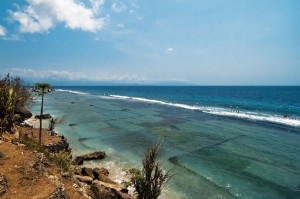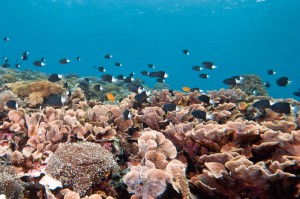Walking around the touristic area of Bali, surrounded by the noise of horns and a thousand motorbikes, anesthetized by car fumes and chased by various kinds of sellers, with their hypnotic refrain, “Transport, yes?” I normally find myself thinking about this paradise island that some of the long-time expats are used to describing in front of a beer, or two, at their favourite bar. I think about streets with few cars, maybe some horse-drawn wagons, no electricity and telephone, wonderful quiet beaches and smiling people, and I really dream about building a time machine to have the possibility to have a look by myself, for just a few hours.
Science is running fast, but probably not fast enough to bring people back in time. So, the only alternative is to find a place, in modern Bali, where we can glimpse the past. Maybe in some little villages in the North, or in some remote mountain areas, time has stopped, or at least slowed down. Another alternative is to take a boat and visit the three islands of Nusa Lembongan, Nusa Ceningan and Nusa Penida.
 Lembongan is quite famous as a tourist destination, especially for surfers and divers, and nowadays it’s not very different from mainland Bali, with the great advantage of the almost total absence of cars. Walking from the main village, Jungutbatu, following the road in direction to the Mangrove forest, a few local houses inhabited by seaweed farmers resist to the growing touristic business. Many of them have no electricity, overlooking the ocean and seaweed plantations, still living like their ancestors did, or at least “modernity” has not yet invaded their lives. If you walk around their village when it’s already dark, it’s not uncommon to see them still working on their seaweed, left drying under the sun during the day. Their daily rhythm is strongly influenced by the tide: when the tide is low, seaweed farms are more easily accessible.
Lembongan is quite famous as a tourist destination, especially for surfers and divers, and nowadays it’s not very different from mainland Bali, with the great advantage of the almost total absence of cars. Walking from the main village, Jungutbatu, following the road in direction to the Mangrove forest, a few local houses inhabited by seaweed farmers resist to the growing touristic business. Many of them have no electricity, overlooking the ocean and seaweed plantations, still living like their ancestors did, or at least “modernity” has not yet invaded their lives. If you walk around their village when it’s already dark, it’s not uncommon to see them still working on their seaweed, left drying under the sun during the day. Their daily rhythm is strongly influenced by the tide: when the tide is low, seaweed farms are more easily accessible.
Considering the speed of touristic development in Lembongan, probably this rural village won’t remain there for long, so hurry up if you want to visit it. Nusa Ceningan, a small island connected to Lembongan with a small bridge, has a couple of interesting surf breaks and nice views on the southern cliffs.
But if you really want to jump into the past, your destination is Nusa Penida, the largest island of the three. Very few tourists land on this 200 square km island, probably because the infrastructure is very limited. Some cheap homestays and basic accommodations are available in the main villages (Toyapakeh, Ped and Sampalan) but don’t expect luxury.
 The lack of infrastructure and, above all, the absence of freshwater keep local and foreign investors far from Penida. And it’s really a shame – or maybe the salvation of the island’s authenticity – because the natural wonders of Penida are astonishing and incredibly various. The north coast, from Toyapakeh to Buyuk, has a long white sandy beach (even if in some places the road, built too close to the sea, has already caused the erosion of the beach) with a worldwide-know coral reef, hosting about 600 species of fish and 250 species of coral. In particular, the dive site in front of Toyapakeh is an incredible coral garden with plenty of healthy hard coral and fish.
The lack of infrastructure and, above all, the absence of freshwater keep local and foreign investors far from Penida. And it’s really a shame – or maybe the salvation of the island’s authenticity – because the natural wonders of Penida are astonishing and incredibly various. The north coast, from Toyapakeh to Buyuk, has a long white sandy beach (even if in some places the road, built too close to the sea, has already caused the erosion of the beach) with a worldwide-know coral reef, hosting about 600 species of fish and 250 species of coral. In particular, the dive site in front of Toyapakeh is an incredible coral garden with plenty of healthy hard coral and fish.
The seaweed farms occupy a large part of the North Penida coast and are the main source of income to the inhabitants of the island. The limestone cliffs of the South, constantly beaten by huge waves, offer a dramatic view of the Indian Ocean. Getting there is very difficult, the area is remote, the roads almost inaccessible, and even locals are not always able to indicate the right direction. But it’s definitely worth it to find the adventurer in you. Consider also the possibility of camping in the area: if you have the necessary equipment, it could be a wonderful experience. Just be sure to have everything you need with you: even hand phones don’t usually work in this area.
Crystal Bay, a must for many divers, is another destination worth seeing. It’s weird to notice that, even if many diving boats head to Crystal Bay on a daily basis, very few people actually disembark on the beach, and you can find yourself alone on a white wonderful tropical beach, like the first tourist in Bali 30 years ago. From a diving point of view, Crystal Bay is one of the best spots to see Oceanic Sunfish (Mola mola) during their annual migration, from June to October. Just take care; Crystal Bay is not a destination for beginners, due to the unpredictable currents and the cold water.
If you want to see something different in the sea, the Goa Karang Sari (Karangsari Cave, near Sampalan) offers an impressive view of stalactites and other limestone formations. But if you really want to feel this glimpse of old Bali, rent a motorbike, take the bumpy road, and get lost on the island.
HOW TO GET THERE:
Nusa Lembongan is easily connected to mainland Bali. Fast and slow boats leave everyday from Sanur Beach to Jungutbatu and, during the high touristic season, to Mushroom Bay. Local villagers usually use other routes coming from Kusamba and Padang Bai: just remember to check the weather first, as safety is not exactly the main strength of these boats.
It’s possible to reach Nusa Penida both from Bali (speed boats from Sanur, slow boats from Benoa, Padang Bai and Kusamba) and from Nusa Lembongan. Chartered small boats from Jungutbatu or the bridge of Nusa Ceningan are always available, and often the boat driver can help you find a motorcycle to rent in Nusa Penida. Always bargain, as the starting price is always at least doubled. Current information is available easily in touristic offices or on wikitravel.org.




